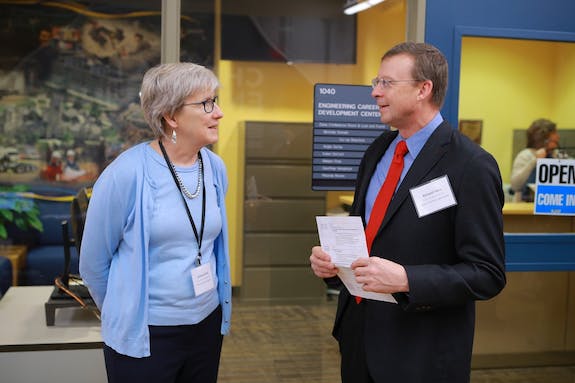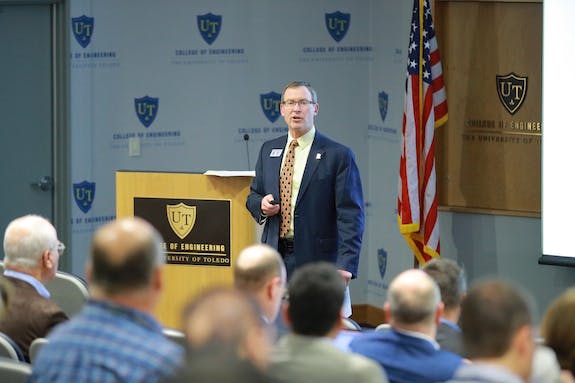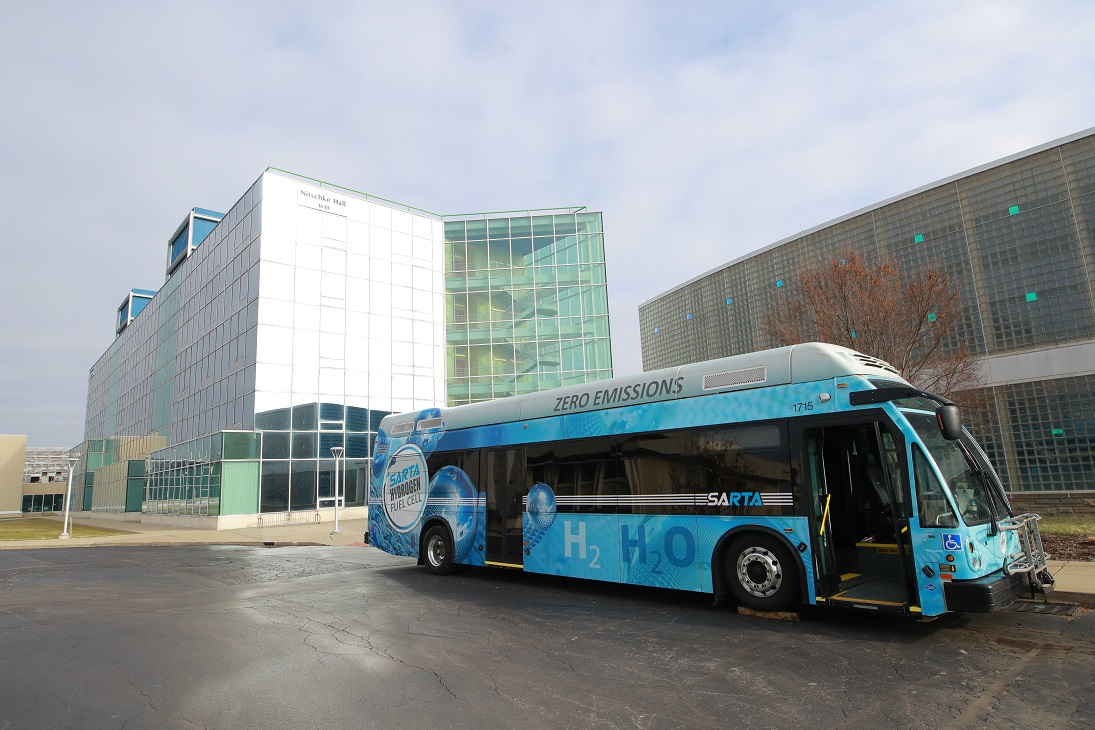From Richard Boardman’s perspective, “We’re transitioning from a hammer looking for a nail, to a carpenter looking for a nail.”
Boardman, of INL Integrated Energy Systems, cites Abraham Maslow’s Law of the Instrument – “I suppose it is tempting, if the only tool you have is a hammer, to treat everything as if it were a nail” – in describing the transformation nuclear energy is undergoing.
And Boardman credits The University of Toledo (UToledo) for convening a diverse group of carpenters more interested in crafting innovative products than in pounding away at the same old nails. This past January, UToledo hosted the Sustainable Energy Economy Workshop: Research & Development of Light Water Reactors and Hydrogen Hybrids. As the follow-up report explains, central to the workshop was to “explore opportunities in repurposing light water nuclear reactors (LWR) for hydrogen production through a hybrid systems design,” with Energy Harbor’s Davis-Besse Nuclear Power Station serving as the laboratory.
“We found a gold mine of experts at the workshop,” said Boardman, Laboratory Relationship Manager for Idaho National Laboratory’s Fuel Cell and Hydrogen Technology Office.
“It wasn’t an arbitrary decision that The University of Toledo was the host,” agreed Constance Schall, a chemical engineering professor at the school. “There’s a spirit of community in the Toledo region that supports diverse partnerships.”
Creation of Western Lake Erie Energy Innovation Hub
Along with that certain spirit are key opportunities in the regional infrastructure and business fabric, and UToledo is deploying the Department of Energy’s nuclear-to-hydrogen initiative by creating a Western Lake Erie Energy Innovation Hub.

“There is a considerable existing market for hydrogen and a lot of promise and potential in this region,” said Alan Scheanwald, a mechanical engineer with Energy Harbor who is the company’s project manager for this effort. “Plus, we’re situated in and around major transportation networks.”
Indeed, the report backs up the long-held real estate adage of “location, location, location.” For example:
- Davis-Besse is located near both the east-west Interstate 80/90 corridor that connects Chicago and New York City, and the I-75 the north-south highway connecting Florida and Georgia to Canada.
- Davis-Besse is within 150 miles of major, existing hydrogen consumers; according to an Argonne National Laboratory study, those facilities already use 1.8 million tons of hydrogen annually.
- Also nearby are “major oil refineries, steel manufacturers, syngas and chemical plants, markets for fuel cell vehicles, and methanol and ethanol plants as potential major consumers of hydrogen.”
- Ohio already has “a strong base of fuel cell component and material suppliers and has demonstrated hydrogen use in public buses. Dayton is a major producer of hydrogen forklift vehicles and Ohio has numerous large warehouses where such vehicles can be used. Trucking is an important Ohio industry that will benefit by hydrogen-powered fuel cell trucks and Ohio is close to major automotive centers.”
Hydrogen has long held a substantial-but-elusive promise for the nuclear energy industry. Scheanwald believes that potential is on the precipice of becoming reality, with Davis-Besse’s primary role being to demonstrate and deploy a 1- to 3-MW low-temperature electrolysis unit to produce commercial quantities of hydrogen.
“The main objective is to boost the revenue of struggling nuke power plants that are competing with cheap natural gas and renewables,” Scheanwald said. He echoed the words of INL’s Bruce Hallbert, director of DOE’s Light Water Reactor Sustainability Technical Integration Office, who described when Davis-Besse was selected to anchor the project.
“This first-of-a-kind project represents significant advances for improving the long-term economic competitiveness of the light water reactor industry,” Hallbert said. “This project also accelerates the transition to a national hydrogen economy by contributing to the use of hydrogen as a storage medium for production of electricity, as a zero-emitting transportation fuel, or as a replacement for industrial processes that currently use carbon-emitting sources in hydrogen production.”
Hydrogen production during low electricity demand
Producing hydrogen is an inverted solution to the notion that nuclear power plants need to ramp up and down with demand and to integrate with renewables. Instead, the plants will produce hydrogen during low-demand times – say, when the wind is blowing or the sun is shining – and thus continue to provide baseload and operate at an extremely high capacity level.

Along with INL and Energy Harbor, partners in the two-year DOE project include Xcel Energy, which owns and operates two nuclear power plants in Minnesota, and Arizona Public Service, which operates the nation’s largest nuclear plant, the Palo Verde Generating Station in Arizona.
“I was pleasantly surprised in the process of organizing this workshop to learn how many companies in the state are already working on this,” said Patricia Relue, associate dean for research and graduate studies at UToledo’s College of Engineering. “I had no idea we have hydrogen buses operating on the edge of Canton.”
Relue, Scheanwald, Boardman and others also marveled at how the workshop brought otherwise disparate worlds together and not only revealed the overlap between those spheres, but also geographic and industrial diversity.
Alongside representatives of large industrial companies such as Air Liquide (France-based supplier of industrial gases) and Cummins (the Indiana-based manufacturer best known for its engines that is now developing fuel cells) were companies few people are aware of, including:
- OCO – An Oregon-based company that uses captured carbon dioxide to make formic acid, displacing fossil-fuel-derived feedstocks. Formic acid has a broad array of uses, from preserving silage (cattle feed) to airplane de-icer.
- Midrex Technologies – The Charlotte, North Carolina, direct-reduction ironmaking technology and services company that is a central player in the rebirth of iron and steelmaking in the American Midwest.
- Nikola Motor – The Arizona company that makes hydrogen-powered fuel cell trucks. Nikola made a splash late in 2019 when it completed what was called the first-ever emissions-free beer delivery, part of its agreement to build 800 trucks for Anheuser-Busch.

Consider just one sector, represented by Nikola – transportation. Pat Valente, executive director of the Ohio Fuel Cell Coalition, explained to fellow conference attendees that Ohio is readying to expand the use of hydrogen fuels. The report pointed out three such areas:
Fuel cell lift trucks: Plug Power, the nation’s leader in this sector, has more than 32,000 fuel cell-powered lift trucks (mostly forklifts) in the field, with over 2,000 in Ohio and neighboring southeast Michigan. Plug Power also has a National Service Hub in Dayton. Companies already using cell lift trucks in Ohio and Michigan include household names Ace Hardware, Walmart, Home Depot, Honda, Amazon, and Chrysler.
Buses: In Canton, the Stark Area Regional Transit Authority has fuel needs for 12 hydrogen fuel cell-powered buses and four planned paratransit vehicles, making it the third-largest hydrogen powered bus fleet in the country. Meanwhile, in Columbus, The Ohio State University Center for Automotive Research (CAR) plans to deploy a hydrogen fuel cell bus to move students in and around the OSU campus.
Heavy- and light-duty vehicles: Deployment of hydrogen-powered cars and trucks is in its infancy, but is expected to grow at a strong pace. Some firms are using light-duties in the region as test vehicles. And there are no known hydrogen trucks operating in Ohio, although in Michigan, the Army is doing work at its Tank Automotive Research, Development and Engineering Center.
Value of transactive energy
The workshop also made Boardman a disciple of what Michael Heben, professor of physics and director of UToledo’s Wright Center for Photovoltaics Innovation and Commercialization, calls “transactive energy,” meaning actions or transactions that imply some sort of agreement.

To reach the desired level of transactive power, Boardman said, “There are four things that must be true.” A synopsis of those four things includes:
- The energy supplied must be constant, reliable.
“That can only come from a nuclear plant,” Boardman said. “Hydrogen users want the energy on a consistent rate. If not, they will need a lot – a lot – of storage.”
- The cost must be low.
“By working together, we will create the critical mass of industrial production,” Boardman said. “And the people in the region are ready to work together, and they believe their costs will come down.”
- There must be a market for the hydrogen.
“We need offtake,” Boardman said about movement of goods to market. At the workshop, “We validated that the market is there,” pointing to several participants, ranging from Lubrizol to General Motors, as well as the Ohio Fuel Cell Association.
- Policy alterations are needed.
“Just like renewable portfolio standards, we need clean energy standards,” he said. “It’s going to take public education to make these policy changes,” including candid discussion that early projects may be costly.
“The synergy is everyone gets higher value for their electricity – the producer and the buyer,” Boardman explained. “It’s a whole new business structure.”
A foundational commitment to safety
While the business structure is changing, nuclear energy’s foundational commitment to safety is not. “For a lot of people who aren’t familiar with the nuclear industry, the elephant in the room is, ‘You’re going to put a hydrogen plant right next to a nuclear power station?’” Energy Harbor’s Scheanwald said.
“The little-known fact is that hydrogen is already used at nuclear plants,” he said, pointing out that boiling water reactors use hydrogen for water chemistry and pressurized water reactors like Davis-Besse deploy hydrogen in cooling applications. “Our industry places nuclear, personal and industrial safety first and foremost in everything we do,” Scheanwald added. “We are not going to put the unit in a place that is not safe.”
UToledo professors Relue and Schall note that the report prompted by the January workshop identifies gaps, challenges and opportunities to advance the Western Lake Erie Energy Innovation Hub. It puts them in three categories:
- Commercialization projects that demonstrate new technologies and systems integration.
- Technology development and commercialization acceleration at the device level, followed by bench-scale testing in preparation for moving up to pilot demonstrations.
- Fundamental R&D conducted by universities and national laboratories.
National labs, industry, and UToledo are working on proposals to continue the momentum and make quantifiable advancements. “In putting joint proposals together, we really had to flesh out university collaborations with INL and industry,” Schall said.
The official seal on Centennial Mall on The University of Toledo’s campus reads, “Coadyuvando El Presente, Formando El Porvenir,” and the Sustainable Energy Economy workshop, report and continuing effort exemplify that motto, which translates to “Guide to the Present, Moulder of the Future.”





